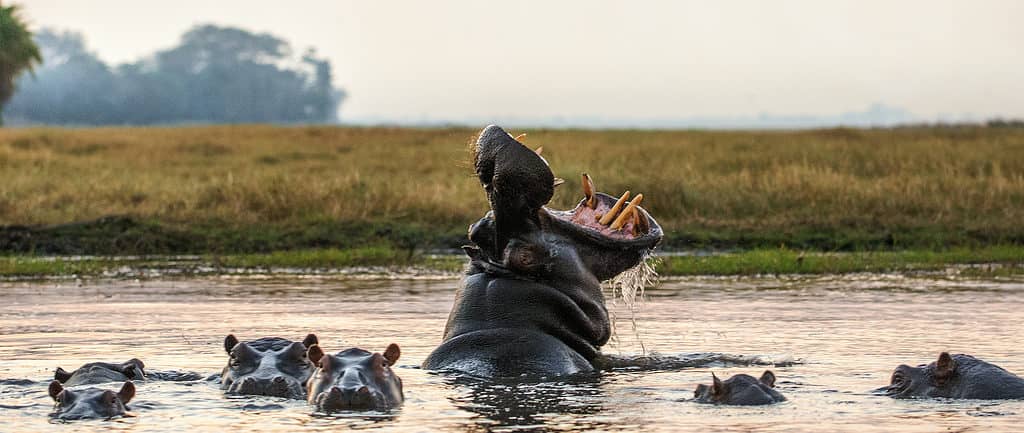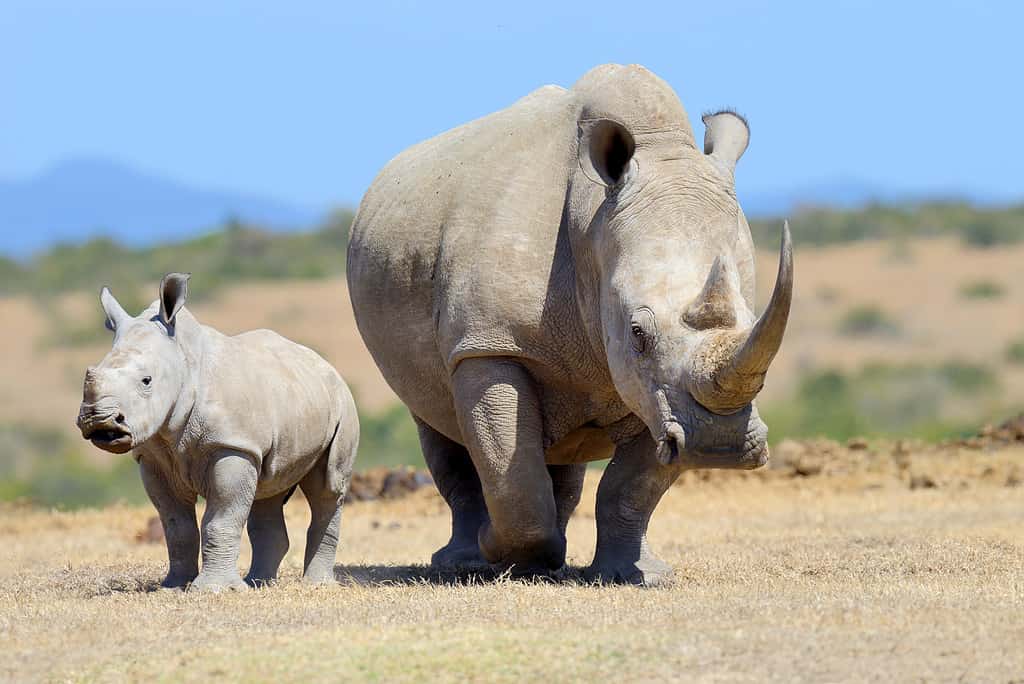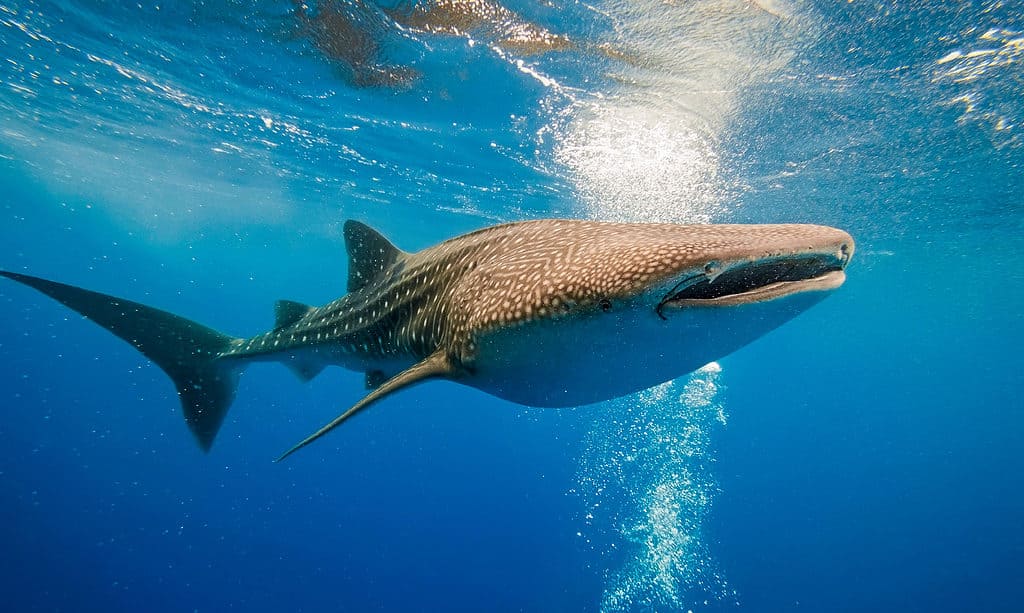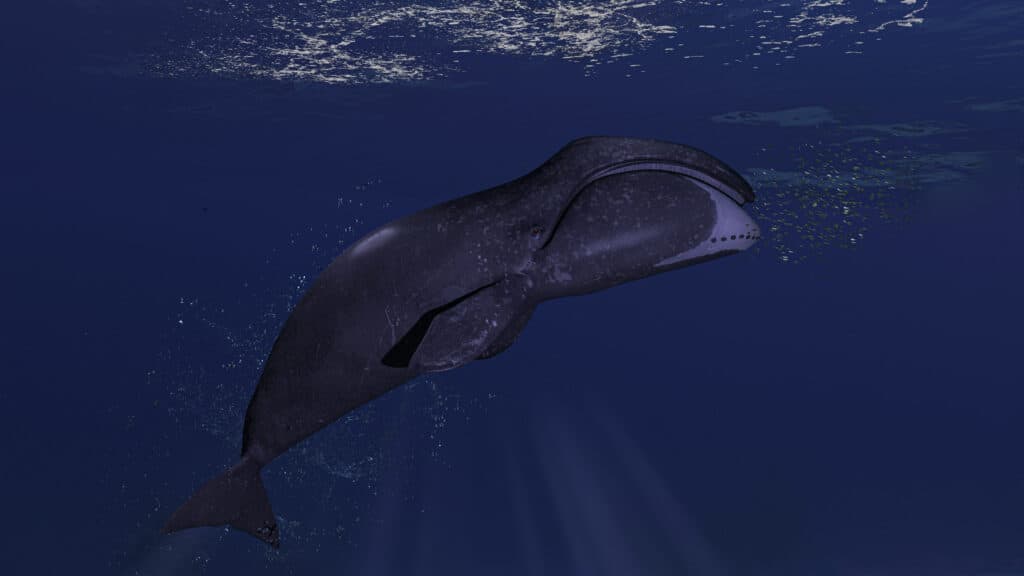When most people think of the world’s largest animals, we don’t often think of the ones with the largest heads specifically. But a big head can be a significant advantage in the animal kingdom–after all, it can mean a larger brain, larger teeth, or even larger eyes, all of which can also be incredibly helpful adaptations for survival. So, which animals have the largest heads of all, and what are their actual measurements? Read on to learn all about the world’s top 10 below!
10. Colossal Squid (Mesonychoteuthis hamiltoni)

The colossal squid’s massive eyes can be the size of a dinner plate at nearly a foot in diameter. Its head and mantle combined make up close to half of its entire body length.
©Rui Palma/Shutterstock.com
Let’s kick off this list of big-headed animals with the world’s largest known invertebrate: the elusive and mysterious colossal squid, of which only a handful of specimens have ever actually been studied. Fortunately, these select few specimens were more than enough for researchers to get some accurate measurements.
Capable of reaching over 1,000 pounds and measuring more than 30 feet long, the colossal squid lives up to its name. Its enormous head and mantle makeup around half of its total body length and can measure 10 to 15 feet long. Notably, it also has the largest eyes of any animal on the planet at a downright frightening 11 inches in diameter!
9. Hippopotamus (Hippopotamus amphibius)

A hippo’s head can weigh nearly half a ton. Its enormous mouth can open so wide it can create a four-foot opening.
©Sergey Uryadnikov/Shutterstock.com
As one of the world’s largest land mammals aside from elephants and rhinos, hippos also have pretty huge heads! On average, a hippo’s head can weigh around 800 to 1,000 pounds, and it takes up a third of its entire body size. Its skull alone typically measures just over two feet long.
In addition to having massive heads, hippos have incredibly large mouths that can widen to over 150 degrees, creating a three-to-four-foot opening. Furthermore, their bite force is stronger than any other land animal on the planet at 1,800 psi, which can theoretically snap an alligator’s body in two. Despite this, they are almost entirely herbivorous and mainly use their powerful jaws as a defense mechanism against potential predators.
8. White Rhinoceros (Ceratotherium simum)

A white rhino’s head can measure over 2.5 feet long and weigh nearly 1,000 pounds.
©Volodymyr Burdiak/Shutterstock.com
The white rhinoceros is the largest of all five known rhino species, with a total body weight of around 3,500 to 5,000 pounds when fully mature. Its head alone can weigh 800 to 1,000 pounds and measure more than two and a half feet long, while the front horn atop its head can reach nearly 60 inches in length.
White rhinos are also notable for having the widest-set nostrils of any land animal. This trait, combined with the many well-developed nasal bones in their heads, gives rhinos an excellent sense of smell. This helps make up for their comparatively poor eyesight.
7. American Bison (Bison bison)

An American bison’s head can measure more than two and a half feet long. Its skull alone can weigh more than 20 pounds.
©Tim Malek/Shutterstock.com
The American bison has a massive head both compared to its body size and in general, with a skull that can weigh over 20 pounds alone! On average, a fully-grown bison’s head measures around two and a half feet long from horns to chin. Its entire body can weigh anywhere from 700 to 2,500 pounds, and its head makes up close to a third of its total mass.
As well as having a large head, the American bison has incredibly large horns that can measure four feet wide. Bison mainly use their horns to fight one another for status within their herds, as well as for defense, though they have very few predators.
6. African Bush Elephant (Loxodonta africana)

An African elephant’s skull alone can weigh over 100 pounds.
©Volodymyr Burdiak/Shutterstock.com
As the largest and heaviest land animal at 5,000 to 13,000 pounds on average, it only makes sense for the African bush elephant to have a pretty massive head. Its gigantic skull can weigh more than 100 pounds alone, while its entire head commonly weighs well over 800 pounds. To support its large head and ears, the African bush elephant has very strong neck muscles.
Complementing the African bush elephant’s enormous head are its large, wide ears, which can grow to more than four feet in width. They can flap their ears to cool down their bodies or extend them to make themselves look even larger to intimidate predators. Fortunately, thanks to their huge size and the fact that they tend to travel in groups, very few predators even bother pursuing them.
5. Basking Shark (Cetorhinus maximus)

Despite its borderline eldritch appearance and three-foot-wide mouth, the basking shark is a non-aggressive, harmless filter feeder.
©Martin Prochazkacz/Shutterstock.com
The basking shark is perhaps best known for its huge, cavernous mouth that can open more than three feet wide. Its similarly massive head can measure around five to seven feet long. As the second-largest shark and fish species, basking sharks can have a body length of more than 40 feet, though they usually average around 20 to 30 feet long.
Thankfully, this frightening-looking species is a harmless filter feeder that spends most of its time eating tiny plankton. They are not aggressive towards humans and move quite slowly through the water at a leisurely 2 miles per hour or so.
4. Sperm Whale (Physeter macrocephalus)

A sperm whale’s head can be over 15 feet long and makeup about a third of its total body length.
©Martin Prochazkacz/Shutterstock.com
The sperm whale is the largest toothed whale as well as the largest toothed predator in general. Its entire body averages a whopping 35 to 50 feet long, while its head makes up around a third of its total body length, making it around 10 to 15 feet long.
Interestingly, the sperm whale is also the most sexually dimorphic cetacean, meaning males and females of the species can vary significantly in size. Specifically, males are around 30% to 50% larger than females on average. While the typical fully-grown male sperm whale usually weighs around 100,000 pounds, females are much smaller at around 35,000 pounds.
3. Whale Shark (Rhincodon typus)

Whale sharks have huge, flat heads and mouths that can measure over five feet wide.
©Krzysztof Odziomek/Shutterstock.com
The whale shark is the largest living fish species, with the longest specimen ever recorded measuring more than 60 feet long. It is easily recognizable thanks to its large, flat head and wide mouth, which can exceed five feet in width. Like the basking shark, though, it is a harmless filter feeder that is known to be quite gentle and even shy around humans.
Whale sharks use their large, wide mouths to engage in two main types of filter feeding: ram filter feeding, in which the shark essentially swims forward quickly and allows the water to push food into its mouth, and suction feeding, where it will suck in large amounts of water and push it out through the gills, swallowing the food left behind.
2. Bowhead Whale (Balaena mysticetus)

Bowhead whale skulls can reach close to 17 feet long.
©iStock.com/bbevren
The bowhead whale has the largest mouth of any animal on the planet, as well as the second-largest head. Its enormous skull alone can measure nearly 17 feet long, and it makes up about a third of its total body length. Its entire body averages 50 feet in length, though specimens exceeding 60 feet have been recorded.
Notably, the bowhead whale’s common name is a reference to its huge, triangular skull. It uses this bulky, somewhat pointed skull to break through layers of ice in the Arctic waters it resides. It’s capable of shattering ice sheets more than eight inches thick!
1. Blue Whale (Balaenoptera musculus)

As the largest animal on the planet, the blue whale also has the largest head, which can reach 18 feet in length.
©Maria Spb/Shutterstock.com
The blue whale is unfathomably huge, with a similarly massive skull that can measure 18 feet long and make up a third of its body length. Its entire body can reach close to 100 feet in length and weigh more than 400,000 pounds, or about 200 metric tons. To give a bit more perspective, that’s more than 20 school buses in weight!
As the largest animal ever known to have existed, the blue whale has no real predators aside from the occasional pod of killer whales. Despite their massive size, they are not predatory themselves and are filter feeders that mainly eat krill. They can be surprisingly curious, social, and gentle towards humans, often approaching boats and divers simply to investigate them.
Top 10 Animal Head Sizes At-a-Glance
| Animal | Head Size |
| 10. Colossal squid (Mesonychoteuthis hamiltoni) | 10 to 15 feet long (head and mantle combined) |
| 9. Hippopotamus (Hippopotamus amphibius) | 800 to 1,000 lbs; ~2 ft. long skull |
| 8. White rhinoceros (Ceratotherium simum) | 800 to 1,000 lbs; 2.5 ft. long head |
| 7. American bison (Bison bison) | ~2-3 ft. long head |
| 6. African bush elephant (Loxodonta africana) | 800+ lbs. head; ~4 ft. wide ears; 100+ lbs. skull |
| 5. Basking shark (Cetorhinus maximus) | 5-7 ft. long head; 3 ft. wide mouth |
| 4. Sperm whale (Physeter macrocephalus) | 10-15 ft. long head |
| 3. Whale shark (Rhincodon typus) | ~5 ft. wide mouth |
| 2. Bowhead whale (Balaena mysticetus) | ~17 ft. long skull |
| 1. Blue whale (Balaenoptera musculus) | ~18 ft. long skull |
The photo featured at the top of this post is © Tim Malek/Shutterstock.com
Thank you for reading! Have some feedback for us? Contact the AZ Animals editorial team.






